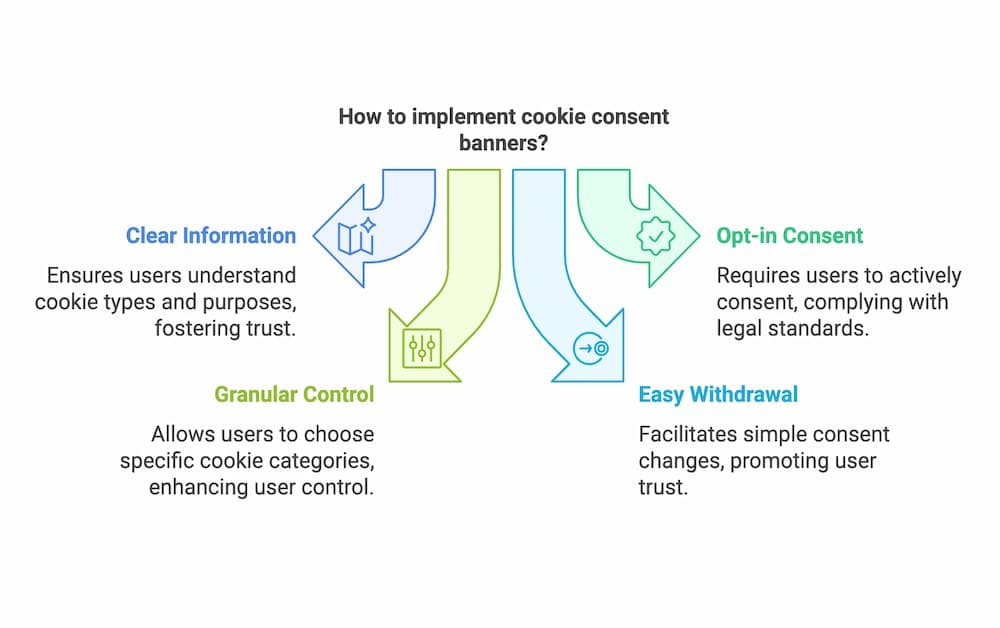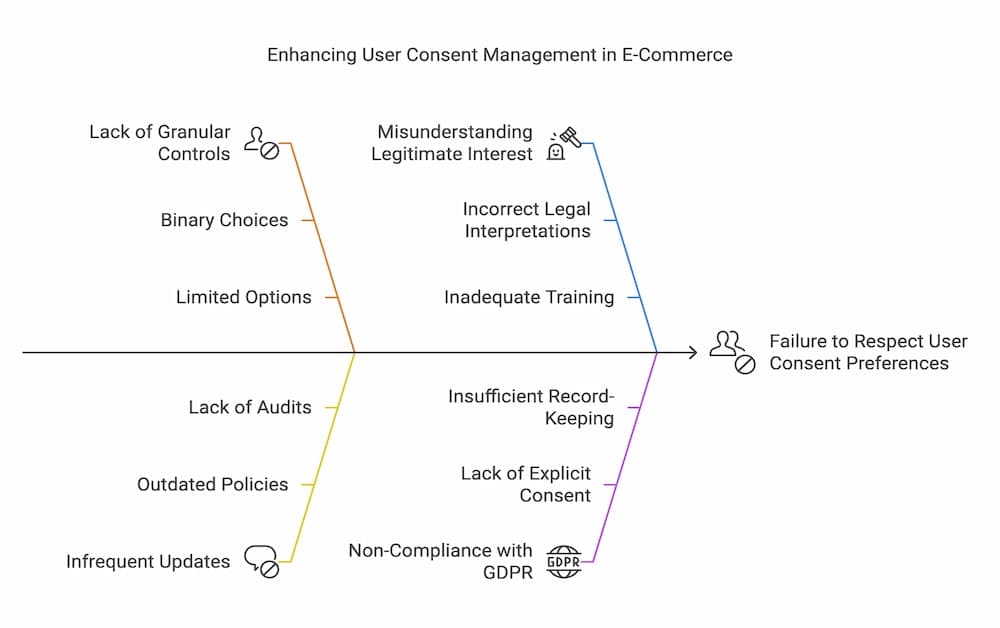Introduction
E-commerce stores and online stores face a complex landscape when it comes to managing cookie consent on their websites. Navigating the legal requirements and best practices surrounding cookies can be daunting, especially for those who are not well-versed in data privacy regulations and common eCommerce mistakes.
The California Privacy Rights Act (CPRA) plays a significant role in regulating cookie consent notices and preventing dark patterns, which are manipulative user interfaces designed to mislead consumers. The CPRA aims to protect consumer privacy rights at the state level and outlines compliance requirements, including prohibiting coercive and manipulative consent practices that undermine user autonomy.
Managing consumer consent is a crucial element for effective data-driven marketing strategies. By ensuring compliant practices around consumer consent, businesses can enhance their marketing effectiveness, build trust, and ultimately drive revenue growth while aligning with regulatory requirements.
However, failing to properly implement cookie consent mechanisms can lead to significant consequences, from loss of customer trust to hefty fines for non-compliance. It’s crucial for e-commerce businesses to understand the common pitfalls and take proactive steps to avoid them.
What are cookie consent banners, and why are they legally required for e-commerce websites?
Cookie consent banners are essential tools for websites that use cookies and other tracking technologies. These banners inform users about the presence of cookies on the site and provide options for managing their consent preferences. The regulatory landscape surrounding user consent for cookies on websites requires that cookie consent notices provide clear, unbiased options for users, ensuring that the design does not manipulate user preferences through deceptive practices.
Cookie notices must provide clear choices to users, contrasting past practices like pre-checked options, which have been deemed illegal. Clear cookie consent banners can help build trust with potential customers by ensuring transparency and control over their data.
Under the European Union’s General Data Protection Regulation (GDPR) and the ePrivacy Directive, websites must obtain informed consent from users before setting any non-essential cookies. This means that users must be given clear information about the cookies used and the purposes for which they are set. Understanding customer behavior can improve the effectiveness of these banners. It is crucial to distinguish between an actual cookie consent mechanism and a mere cookie notice, as failing to obtain proper user consent for cookie usage can have significant legal implications.
Essential cookies—those strictly necessary for the website to function properly—can be set without obtaining consent. However, all other types of cookies, such as those used for analytics, advertising, or personalization, require explicit opt-in consent from the user.
Failing to obtain valid consent for non-essential cookies can result in significant fines and reputational damage. The GDPR allows for penalties of up to €20 million or 4% of a company’s global annual revenue, whichever is higher.
To ensure compliance and maintain user trust, e-commerce businesses must implement cookie consent banners that meet the following criteria:
Clear and comprehensive information: Users should be provided with easily understandable details about the types of cookies used, their purposes, and any third parties involved.
Explicit opt-in consent: Pre-ticked boxes or implied consent are not sufficient. Users must take clear, affirmative action to indicate their consent for non-essential cookies.
Granular control: Users should have the ability to accept or reject specific categories of cookies rather than being presented with an all-or-nothing choice.
Easy to withdraw consent: Users must be able to change their consent preferences at any time, with the process of withdrawing consent being as simple as giving it.
Implementing a legally compliant cookie consent banner, like those offered by Pandectes, is not only a regulatory requirement but also a demonstration of respect for user privacy. By prioritizing transparency and user control, e-commerce businesses can foster trust and build long-lasting relationships with their customers.

Lack of an explicit “Reject All” button
An oversight in many cookie consent banners is the missing “Reject All” button, which challenges the principles of transparency and user empowerment. Without a clear option to reject non-essential cookies, users are left without a straightforward means to manage their data preferences, undermining the user-centric approach demanded by privacy regulations. Addressing customer complaints about the lack of a “Reject All” button can improve user trust and compliance.
Regulators emphasize that the process of rejecting cookies should be as uncomplicated as accepting them. This requirement ensures users can make genuine choices without encountering manipulative interface designs. Cookie banners that limit visibility or access to the “Reject” option, often through additional steps or complex navigation, are in direct conflict with regulatory expectations. Such practices, which can be categorized as dark patterns, compromise user choice and may attract regulatory scrutiny.
To meet compliance standards and enhance user confidence, cookie consent banners must present “Reject All” buttons with equal visibility and accessibility as “Accept All” options. This balanced approach in button design supports fairness and aligns with user privacy rights. By committing to user-friendly consent solutions, e-commerce businesses can reinforce their dedication to privacy standards and demonstrate respect for user preferences.
Setting cookies before obtaining informed consent
Implementing cookies before securing prior consent represents a frequent oversight that can lead to significant regulatory concerns. Allowing cookies to activate automatically without user input contravenes the stringent consent mandates outlined by privacy frameworks such as the GDPR. This practice undermines the foundation of informed consent, as it assumes user approval without any deliberate action. Ensuring compliance with these regulations is crucial for enhancing customer satisfaction.
To mitigate this issue, it’s vital to ensure all non-essential cookies remain inactive on a user’s device until users grant explicit permission. Consent management systems need to be configured to postpone cookie scripts, safeguarding against premature data collection or processing. This approach not only aligns with compliance requirements but also demonstrates a commitment to respecting user autonomy and privacy preferences.
Advanced consent solutions should integrate seamlessly within a website’s infrastructure, preventing any instances of non-compliant cookie deployment. These solutions must incorporate dynamic controls to guarantee that cookie scripts remain dormant until the user has interacted with the consent interface. By adopting this strategy, businesses can maintain the integrity of user data protection, fostering an environment of trust and transparency with their online audience.
Confusing or incomplete information about cookies
Effective communication in cookie consent banners is crucial for ensuring users understand how their data is being used. Many banners fall short by using ambiguous or overly technical terms, leaving users uncertain about what data is collected and its intended use. This lack of clarity can erode user confidence and raise compliance issues, as transparency is a key requirement of data protection regulations. Many websites face challenges in achieving compliance with cookie consent regulations, often falling short of providing clear information and obtaining explicit user consent, which can lead to legal issues. Clear communication about cookies is especially important for any e-commerce business to build trust and ensure compliance.
To address these challenges, consent banners should specify the types of cookies in use, clearly explaining their functions and any third-party data sharing. Users need to be informed about the specific purposes of data collection, whether it’s for analytics, personalization, or marketing, as well as the identities of third-party entities involved. This detailed information empowers users to make informed privacy decisions and strengthens the trust between the business and its customers.
Additionally, a robust cookie policy should be readily accessible and consistently updated to reflect any changes in data practices. This policy acts as a comprehensive resource for users, detailing cookie usage and any modifications over time. By keeping this policy current and easily accessible, businesses can demonstrate their commitment to transparency, aligning with both consumer expectations and legal standards.

Failure to respect user consent preferences impacts customer satisfaction
Ensuring user consent preferences are upheld is a crucial component of ethical data management. It is necessary to obtain explicit user consent before loading non-essential cookies on a user’s device. Some websites inadvertently ignore or override user selections, which can lead to significant breaches of data protection rules and erode consumer trust. It’s essential for businesses to faithfully execute the choices users make concerning cookie settings, treating these preferences as binding directives that guide data interactions. Respecting user consent preferences can build trust with potential customers. This practice is particularly crucial for e-commerce businesses, which must innovate and improve customer experiences to remain competitive in a crowded market.
It is also important to obtain user consent before loading Google Analytics and other non-essential cookies. Failure to comply with GDPR requirements can lead to serious violations, emphasizing the need for specific and granular consent regarding the use of tracking technologies like Google Analytics.
To achieve this, companies must implement sophisticated consent management systems capable of accurately capturing and maintaining detailed records of user selections. These records should be comprehensive, allowing for easy retrieval and verification to demonstrate compliance with data protection laws. By maintaining such records, businesses affirm their commitment to respecting user autonomy and legal standards.
Additionally, technology systems should be designed to communicate user consent choices effectively to all relevant third-party vendors involved in processing activities. This ensures that user preferences are uniformly respected across the entire data ecosystem. Through these practices, businesses can uphold user rights and promote a transparent and trustworthy digital environment.
Not offering granular cookie controls
Incorporating detailed cookie controls into consent mechanisms is crucial for providing users with the flexibility to manage their privacy settings. Users often wish to exercise discretion over which types of cookies they allow, such as enabling performance-enhancing cookies while opting out of those used for targeted advertising. Presenting users with a binary choice limits their ability to tailor privacy settings to their preferences, potentially leading to frustration and diminished trust. Failing to offer such granular controls is a common ecommerce mistake.
To address this, consent banners should clearly delineate cookie types—such as necessary, functional, analytics, and marketing—enabling users to make informed decisions about their data interactions. This structured approach not only complies with privacy regulations but also accommodates the diverse privacy preferences of users, facilitating a more personalized online experience.
Equally important is the capability for users to modify their cookie preferences whenever needed. This requires consent systems to be adaptable, providing users with ongoing access to review and change their settings in line with evolving privacy needs or preferences. By implementing such adaptive consent solutions, businesses underscore their commitment to transparency and user agency, thereby fostering a more reliable and trustworthy digital relationship.
Infrequent consent banner and cookie policy updates
The pace at which digital platforms integrate new features and third-party services necessitates ongoing vigilance in updating consent frameworks. Websites frequently adopt new tracking technologies, adding layers of complexity to data management. Therefore, it is crucial for consent banners and cookie policies to undergo regular revisions to represent current data practices accurately. This practice is especially important for maintaining an effective e-commerce site.
Neglecting routine updates can lead to compliance lapses, as outdated consent documents may fail to account for recent changes in cookie usage. This oversight compromises transparency and could diminish user trust. To mitigate such risks, it is essential to conduct periodic audits of all cookies and tracking technologies used, ensuring they align with the latest legal standards and reflect any new functionalities introduced.
Implementing a structured update process is key to maintaining compliance. This process should include regular evaluations of tracking mechanisms, assessments of third-party data interactions, and quick adaptation to regulatory shifts. By proactively managing consent updates, businesses can uphold their commitment to privacy and bolster consumer confidence in their digital operations.

Improper use of legitimate interest for cookie consent
Relying on legitimate interest to justify the deployment of cookies is a common misconception that can lead to non-compliance with data privacy regulations. Some websites mistakenly believe that legitimate interest can be a lawful basis for setting cookies that require explicit user consent under the GDPR and ePrivacy Directive. This misunderstanding poses significant legal risks, as legitimate interest should only be applied to scenarios where data processing minimally impacts privacy and meets specific regulatory criteria. Some websites present cookie notices that do not provide real consent options, categorizing them as ‘just a notice’.
Legitimate interest cannot replace the need for explicit consent when it comes to cookies used for tracking, analytics, or marketing purposes. The regulatory framework mandates that non-essential cookies require an opt-in from users. Differentiating between essential and non-essential cookies is crucial; only cookies necessary for core website functions, such as those managing secure transactions, can bypass the consent requirement. This practice is particularly important for an e-commerce store to ensure compliance and maintain customer trust.
Conclusion
Navigating the complexities of cookie consent and data privacy regulations can be daunting for e-commerce businesses. However, by understanding and avoiding these common mistakes, you can create a compliant and user-friendly consent experience that builds trust with your customers. If you’re looking for a comprehensive solution to streamline your cookie consent management and ensure compliance with GDPR and other privacy regulations, try Pandectes GDPR Compliance, and let us help you protect your customers’ privacy while growing your Shopify store with confidence.



